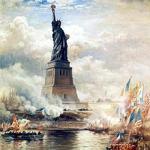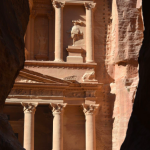reviewing:
The first chamber sets up the thesis of “Damage Control: Art and Destruction Since 1950,” at the Hirshhorn Museum in Washington through May 26. As visitors enter, a 1950s filmstrip plays, showing nuclear blasts recorded for the U.S. Atomic Energy Commission. To one side, so you only see it once you’re already in the room, there’s a smashed baby grand piano with an axe still sticking out of its body: the remains of a 2013 performance art piece in which Raphael Montañez Ortiz hacked the thing up on the Hirshhorn’s plaza. This opening juxtaposition suggests that artworks focused on destroying art—or destroying some symbol of modernity, such as industrial tools or cars—are in some way the same kind of act as political events that threatened the world with destruction. They have something in common and thus can be fruitfully compared.
Even in this first room, though, there are hints of the complications to come, which will ultimately undermine the idea that “art and destruction” is a coherent concept. The nuclear blasts are just beautiful, for one thing. On pockmarked and striated black-and-white film or in glowy, painterly color, the blasts swell in impossible sunrises; the explosion blossoms and then the cloud spires up into the sky. There’s a confused, balked rush of clouds along the ground, or a yellow starburst in a red sky, shot in tight focus. There are several ways to “read” this beauty: Even nuclear weaponry can’t overcome the beauty inherent in the natural world; the explosions become more beautiful because we know what they are, because they call to the death drive, the longing for the world’s last day. Or, perhaps, it’s easy to make destruction beautiful if you only show things and not people.
There are very few human beings depicted in the first several rooms of the large, meandering show. Lots of crashed cars, but no blood; apparently no one has been injured or killed. Small knots of nondescript figures might hang around at the edges talking or holding up traffic signals, but mostly it’s just buildings and bombs and fighter planes.
This isn’t the only way to depict destruction. I felt the absence of any artwork like Lee Miller’s 1945 photograph of a silhouetted German opera singer, Irmgard Seefried, lifting her hands and singing “Madama Butterfly” in the ruins of the Vienna Opera House. The lack of human beings in these artworks became so oppressive that when we finally reached the 1960s (the show is organized chronologically), Andy Warhol’s prints of car crashes filled with mangled bodies actually felt humanistic rather than voyeuristic. At least he shows the cost!











